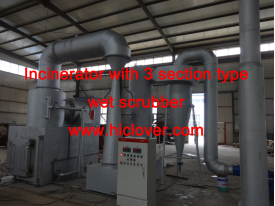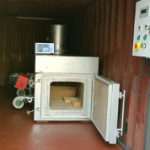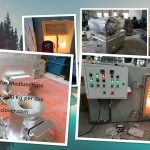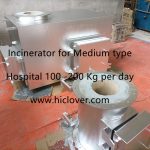3.1. THE PRESENT SITUATION IN SOUTH SUDAN IS HOSTILE, UNPREDICTABLE AND TO COMPOUND THE CHALLENGES, LOGISTICS BECOME DIFFICULT DURING THE RAINY SEASON (TYPICALLY MAY TO OCTOBER). DESPITE THE SECURITY SITUATION AND THE YEARLY RAINY SEASON, THE VENDOR SHALL SUPPLY AND DELIVER THE REQUESTED EQUIPMENT/SPARE PARTS AND PROVIDE SUPPORT SERVICES
Manufacturers : 4.1. THE CONTRACTOR SHALL ENSURE THAT THE ITEMS DELIVERED ARE CONSISTENT WITH THE ITEMS REQUESTED BY UNMISS AND COMPLY WITH THE REQUIRED SPECIFICATIONS. 4.3. THE VENDORS SHOULD NOTE THAT THE SUPPORT SERVICES TO BE PROVIDED SHALL BE CONSISTENT WITH THE SERVICES REQUESTED BY UNMISS. 2
2
QUALITY STANDARDS
7.1. ’THE WASTE INCINERATOR SLIOULD BE MANUTACTIIRCD BY AN ISO 9001:2015 OR EQUIVALENT STANDARDS CERTIFIED COMPANY.
7.2. THE WASTE INCINERALOR SLIOULD INCORPORATE AN AIR POLLUTION CONTROL SYSTEM CONFORMING TO EU BASIC EMMISSION STANDARD OR ITS EQUIVALENT AS WELL AS HEALTH AND SAFETY SYSTEMS OF INTERNATIONAL STANDARDS.AGRICULTURAL WASTE INCINERATORS WITH A LOADING BAY EQUIPPED WITH A WASTE FEEDER RAM TO ALLOW FOR CONTINUOUS LOADING OPERATION
INCINERATOR SPECIFICATIONS
THE VENDOR SHALL BE RESPONSIBLE IVOR THE SUPPLY. DELIVERY, INSTALLATION, AND COMMISSIONING OT’TLIE WASTE INCINERATOR AND ALSO FOR PROVIDIRLG COMMISSIONING AND OPERATIONAL TRAINING .TO THE OPERATORS. THE REQUIRED SPECIFICATIONS FOR WASTE INCINERATORS ARE:
6. HAVE VERY LOW LEVELS OF UNBUMED MATERIAL IN THE SLAG.
7. SHALL BE USER FRIENDLY AND AS LABOR FREE AS POSSIBLE, EASY TO USE AND OPERABLE BY TRAINED OPERATOR OR UNSKILLED OPERATOR.
INCINERATOR SPECIFICATIONS HICLOVER, Nanjing Clover Medical Technology Co.,Ltd, supply system solutions for medical environmental protection, animal and pet cremation engineering, other municipal solid waste incineration project.
We supply single combustion chamber, double combustion chambers, three combustion chambers and multi-combustion chambers waste incinerators for laboratory, clinic, hospital, medical center, hygiene clinical waste destruction with medical disposable, biological waste, medical plastic waste, hazardous waste, red bag waste, needle disposal, gauze and bandages, sealed sharp containers, pathological waste, trace-chemotherapeutic wastes, etc.
8. AS MUCH AS POSSIBLE, PRODUCE END-PRODUCTS AND BY-PRODUCTS WITH MINIMUM NEGATIVE IMPACT ON THE ENVIRONMENT AS PER INDUSTRY BEST PRACTICES.
9. HIGH EASE OF INSTALLATION AND OPERATION WITH ROBUST AND USER-FRIENDLY INSOUMENTATION AND CONTROLS INCLUDING CLEARLY READABLE SYSTEM OPERATION PANELS.. 10. IT SHALL BE CAPABLE OF HANDLING FOOD WASTE MIXED WITH NON-RECYCLABLE WASTE. IT SHOULD ACCOMMODATE LARGE VARIATIONS IN WASTE COMPOSITION AND CALORIFIC VALUE.
11. ALLOW FOR CONTINUOUS LOADING.
INCINERATOR SPECIFICATIONS :
12. SHALL BE ECONOMICAL TO OPERATE AND MAINTAIN AND HAVE .A LOW AND EFFICIENT FUEL CONSUMPTION. BIDS SHOULD INCLUDE THE FUEL CONSUMPTION AT THE RATED CAPACITY .
13. SHALL INCLUDE A DETAILED OPERATION AND MAINTENANCE MANUAL IN ENGLISH. IN ADDITION, THE MANUAL MUST HAVE TROUBLESHOOTING AND DETAILED DESCRIPTIONS AND PICTURES OF THE INDIVIDUAL COMPONENTS OF THE INCINERATOR 8
TECHNICAL SPECIFICATIONS: INCINERATOR:
A. LIFETIME OPERATION FOR A MINIMUM PERIOD OF 10 YEARS IN A TROPICAL ENVIRONMENT, B. FEATURE A COMBUSTION CHAMBER UP TO MAXIMUM 1.5M3
C. NOMINAL BURNING RATE SHALL BE UP TOL00 KG/H WITH 8 HOUR DAILY OPERATING CYCLE OF ASH REMOVAL, PRE-HEAT AND BURN WITH CONTINUOUS LOADING,
D. POWER SHALL BE TYPICALLY SUPPLIED BY EITHER DIESEL GENERATOR, THE LOCAL GRID OR A COMPOUND .SCALE MINI GRID. ELECTRICITY IS NEEDED TO RUN THE FANS, BLOWERS, .THE DISPLAY READOUTS IN THE CONTROL PANEL, ETC. WHILE DIESEL FUEL IS USED AS A SUPPLEMENTAL FIIEL FOR INCREASING THE FEEDSTOCK CALORIFIC VALUE, BUNTERS WILL .ONLY .ACTIVATE WHEN AND IF REQUIRED (DURING PREHEATING OF THE PRIMARY CHAMBER AND IF NEEDED LATER TO REACH THE 850C, FOR SHORT INTERVALS.) 9
9
TECHNICAL SPECIFICATIONS: INCINERATOR:
E. INCLUDE A SUPPLEMENTAL FUEL SOURCE AND STORAGE UNIT E.G. DIESEL TANK) OF AT LEAST 1,000 LITERS,
F. THE BURNERS SHALL BE FITTED WITH LOW NOX TECHNOLOGY TO ENSURE A COMPLETE AND CLEAN BURN CYCLE, G. THE WASTE INCINERATORS SHALL BE DESIGNED FOR 3 PH, 4 WIRE, 415VAC, +-3% ELECTRICITY SUPPLY,
H. MUST HAVE DUAL COMBUSTION CHAMBERS THAT CONFORM TO A MINIMUM GAS TEMPERATURE OF 850 C WITH A 2-SECOND RETCNTION OF FIRE GASES FOR SECONDARY CHAMBERS. 10
10
TECHNICAL SPECIFICATIONS: INCINERATOR:
I. HAVE A MINIMUM THERMAL EFFICIENCY OF’85%,
J. GENERATE RESIDUAL INCINERATOR ASH CONFORMING TO <L0%1Y VOLUME AND <25% BY WEIGHT OF THE WASTE INCINCRATED,
K. ACHIEVE A TOTAJ ORGANIC CARBON (TOC) CONTENT IN THE SLAG AND BOTTOM ASHES OF LESS THAN 5%,
L. ALL METAL SURFACES (EXCEPT COMBUSTION CHAITLBER INTERNAL FITTINGS) SHALL BE EITHER GALVANIZED, CNAMELED, PAINTED, OR OTHERWISE TREATED AGAINST ATMOSPHERIC AND PROCESS INDUCED CORROSION.
M. PRIMARY AND SECONDARY CHAMBERS SHALL PREFERABLY HAVE ROUNDED INSIDE CORNERS TO AVOID THE I(I1NIATION OF DEAD ZONES OR COLD POCKETS.
N. COMBUSTION EFFICIENCY (CF’I) AT LCFLST 99% WITH ADEQUATE CAPACITY BURNERS IN SUFFICIENT NUMBER FOR THE VOLUME OF THE PRIMARY CHAMBER TO ENSURE EFFECTIVE OPERATIONS. 11
TECHNICAL SPECIFICATIONS: INCINERATOR:
O. INCINERATOR UNITS SHALL INCLUDE AN INTEGRAL AND MECHANIZED BOTTOM ASH REMOVAL SYSTEM
P. ALL THE MEASURING DEVICES ATTACHED WITH THE INCINERATOR SHOULD HAVE DIGITAL DISPLAY AND SHOULD HAVE PT OVISION OF CONNECTING TO THE RECORDING SYSTEM, WHICH SHOULD INCLUDE FUEL METER AND SEPARATE ENERGY METERR.
Q. INCLUDE DESIGNED POLLUTLON CONTROL DEVICES SUCH AS SCRUBBERS, FILTERS, OR ELECTROSTATIC PRECIPITATORS TO ACHIEVE EU EMISSION LIMITS AS PART OF AIR POLLUTION CONTROL SYSTEM SUITABLE FOR EMISSION CONTROL.
R. EACH UNIT SHALL INCLUDE A COMPLETE VERTICAL EXHAUST AND STACK SYSTEM 6 TO 12 M ABOVE GROUND LEVEL WITH EXHAUST EXIT VELOCITY OF NOT LESS THAN 10 METERS PER SECOND
S. THE CONTROL PANEL SHOULD BE AT LEAST 1P54 RATED 13
13 INCINERATOR SPECIFICATIONS
1. SHALL BE COMMON, WELL-PROVEN AND CLEAN TECHNOLOGY BOTH AS A COMPLETE UNIT AND IN TERMS OF ITS INDIVIDUAL COMPONENTS.
2. SHALL BE ROBUST, STURDY, AND CAPABLE OF INSTALLATION IN REMOTE LOCATIONS SUBJECT TO SEVERE AND HARSH CONDITIONS.
3. SUITABLE FOR MODULAR APPLICATION INCLUDING SLAPPING AND TRANSPORT.
4. FLEXIBLE AND MOBILE LO ALLOW FOR ON-SITE TIEATMENHOPERATION —MUST BE CONTAINERIZED. 5. RELIABLE AND ROBUST TOTAL INCINERATION PROCESS.CONTAINERISED WASTE INCINERATOR
INCINERATOR UNIT COMPLETENESS, SIZ.E AND EFFIEIENCY :
THE PROPOSED INCINERATOR UNITS MUST BE COMPLETE AND INCLUDE ALL THE KEY FEATURES LISTED BELOW AND ALL THE ASSOCIATED SUPPORT SERVICES AND INTERCONNECTIONS TO MAKE IT FUNCTIONAL AND OPERATE OPTIMALLY.
THE FORECASTED FEEDSTOCK LOADS, AND DAILY LOADING RATES ARE GENERALLY SUMMARIZED AS:
A. PRIMARILY FOOD WASTE AND PACKAGING WITH AWIDC RANGE OFCALORILIC VALUES AND DENSITIES. THE CONTENT OF THE CONBUSTIBLE MATTER WILL BE ABOVE 60% AND .MOLSTTIRE CONTENT UP TO 70%.
B. WASTES EITHER SMALL ENOUGH TO FIT WITHLN A 60-LITRE WASTE SACK OR BROKEN UP OR SHREDDED TO LESS THARI 300MM IN SIZE.
C. OPERATION ON A DAYIINE SHFT BASIS . 5 DAYS PER WEEK 14
14 • DEYELOP AN OPERATING PROTOCOL.FOR UNMISS NOMINATED STAFF TO USE FOR OPERATIIIG THE UNITS.
UNPACKING, INSTALLÄTION, AND COMMISSIONING OF THE UNITS:
ALL ASSOCIATED FITTINGS AND CONNECTIONS TO ENABLE FULL IIMCTIONALITY SHALL BE COMPLETED BY THE CONTRACTOR IN LINE WITH THE MANUFACTURER’S INSTRUCTIONS; ILICLUDING BUT NOT LIMITED TO PIPING, ELECTRICAL AND STACLC CONNECTIONS, FOUNDATIONS, ANCHORAGE TO FOUNDATIONS, AS APPLICABLE,
UNMISS SHALL PROVIDE 4HE TEMPORARY PROVISION OL’A FORKLIFT, LIGHT CRANE, TOOLS OR ANY ASSOCIATED MOVING AND LIFTING LNACLBNERY,
INCINERATOR UNIT COMPLETENESS, SIZ.E AND EFFIEIENCY :
D. AN 8 HOUY DAILY OPSRATIIIG CYCLC OF ASH REMOVAL, PRE-HEAT AND BURRT WITH CONTINUOUS LOADING. THE AUTOMATED BURN COMPLETION AND COOL DOWN CYCLE WILL TAKE PLACE OVEMIGHT.
E. THE INCLNERATORS SHALL BE CAPABLE OF USING DIESEL DUEL AS A SUPPLEMENTAL FUEL WHILE THE ASSOCIATED MANAGEMENT EQUIPMENT SHALL BE CAPABLE OF USING ELECTRICITY AS THE PRIMARY POWER SOURCE.
F. PERFORMANCE SHALL MEET EU EMISSION STANDARDS OR EQUIVALENT INTERNATIONAL EMISSION5 STANDARDS THE INCINERATORS TO BE PROCURED WILL CONFORM THE FOLLOWING SIZE CAPABILITIES TO MNNAGE THE F’ORECAST FEEDSTOCK LOADS AND DAILY LOADING RATES AND MUST BE EFFICIENT IN ITS DEMAND FOR FUEL ALID OTHER UTILITIES. 15
The incinerator burn waste in primary combustion chamber and burn the smoke from primary combustion chamber again to make sure environmentally friendly with no black smoke, smelless, reduce pathogenic bacteria infection.
System solutions for medical waste environmental, including waste incineration, smoke emission treatment, high-temperature sterilization, ultraviolet sterilization lamp, waste shredder, needle destroyer, medical waste package, sharp containers, etc.
The pet cremation equipment humanized design with movable platform, small space covers for modern pet cremation business owner all over the world.
QUALITY STANDARDS
7.5. THE UNMISS ELIGINEERING SECTION WILL ASSIGN A REPRESENTATIVE/S TO SUSPECT THE ITEMS DURING DELIVERY TO ENSURE THAT MATERIALS/PRODUCTS PROVIDED ARE OF TIRE REQUIRED QUANTITY AND QUALITY INDICALED IN THE CATALOGUES/BROCHURES.. 7.6. ANY DISCREPANCIES IDENTITIED DURING THE INSPECTION AND RECEIVING PROCESS WILL RESULT IN THE REJECTLON OF THE ITEMS BY UNMISS.
7.7. REJECTED ITELNS/PRODUCT.S SUPPLIED BY THC CONTRACTOR SHALL BE REPLACCD AT THE COST OF THE CONTRACTOR. THE CONTRACTOR SLIALL BE RESPONSIBLE FOR ENSURING THAT THE ITEMS/PRODUCTS ARE REPLACED WITHIN A MAXIMUM PERIOD OF SIXTY (60) CALENDAR DAYS.
7.8. ALL ITEMS/PRODUCTS SHALL HAVE A MINIMUM WARRANTY PERIOD OF TWO (2) YEARS 4
CONTAINERIZATION :
THE PROPOSED INCINERATORS SHALL BE BUILT INTO STANDARD 20FT ISO CONTAINERS.OR ALTERNATIVELY BUILT INTO SIMILAR FOOTPRINT COMPLETE WITH ISO LOAD HANDLING FACILITIES (HOOLCS, EYCLETS, ETC). THE NUMBER OF CONTAINERS/CONTAINER SIZED MODULES REQUIRED FOR EACH UNIT IS AT.THE DISCRETION OF THE CONTRACTOR.
EACH CONTAINER SHALL BE PAINTED WHITE WITH THE “UN” LOGO PAINTED IN BLACK. UNMISS WILL PROVIDE THE PRECISE SPECIFICATIONS FOR PAINTING PRIOR TO CONTRACT AWARD 16
CORROSION RESISTANCE AND WEATHER PROOFING:
THE INCINERATOI UNITS SHALL BE DESIGNED TO LAST IN OPERATION IN, A HARSH ARID ENVIRONMENT FOR A MINIMUM PERIOD OF 10 YEARS IF THE SPECIFIED MAINTENANCE SCHEDULE IS FOLLOWED. ALL METAL SURFACES (EXCEPT COMBUSTION CHAMBER INTERNAL FITTINGS) SHALL BE EITHER GALVANIZED, ENAMELED, PAINTED OR OTHERWISE TREATED AGAINST ATMOSPHERIC AND PROCESS INDUCED CORROSION AS WELL AS EXTREMELY HIGH TEMPERATURES AND HARSH WINDS. THE INCINERATOR COMBUSTION CHAMBER(S) SHOULD BE DESIGNED FOR EASY MAINTENANCE OF ALL INTERNAL PANS INCLUDING THE REFRACTORY AND INSULATION. MATERIALS USED IN THE INDIVIDUAL PARTS OF THE INCINERATOR SHALL BE HEAT RESISTANCE AND BE PROTECTED AGAINST OXIDATION AND CORROSION. 17
17
CORROSION RESISTANCE AND WEATHER PROOFING:
THE INCINERATOR SHELL SHALL BE MADE OF MILD STEEL WITH AN ADEQUATE TLIICLCNESS (MINIMUM..3 MM) AND PAINTED EXTERNALLY WITH HEAT RESISTANT ALUMINUM PAINT SUITABLE TO WITHSTAND 250 C. THE OUTSIDE SURFACE TEMPERATURE OF THE INCINERATOR EASING SHOULD NOT EXCEED 50°C ABOVE AMBIENT TEMPERATURE AND SHALL INCLUDE A SAFETY MESH AROUND ALL HOT SURFACES. HIGH QUALITY COLD FACE REFRACTORY LINING OF CALCIUM SILICATE OR SUPERIOR MATERIAL, MINIMUM THICKNESS 100 MM.. 18
19 DECOMMISSIONING, OVERHAUL, AND REPACING OF THE UNIT:
BASED UPON A POTENTIAL NEED FOR AN INCINERATOR UNIT TO BE IIIOVED TO A NEW LOCATION THE CONTRACTOR WILL OUTLINE THE KEY STEPS THROUGH A CLEAR WRITTEN PROCEDURE AND DIRECT OR REMOTE DEMONSTRATION BY THE CONTRACTED OPCRATOR FOR THE DECOMRRIISSIONING AND REPACLCING OF THE UNITS, SO THIS CAN BE ACHIEVED.
EAOH INCINERATOR SLIALL BE SUPPLIED WITH ALL NECESSAIY ASSCMBLYJDISASSENIBLY AS WELL AS MAINTENANCE TOOLS.
WASTE FEEDER RAM: THE UNIT SHALL INCLUDE A HORIZONTAL AXIS HYDRAULIC RAM FEEDER FOR PUSHING THE WASTE FROM THE LOADING BAY INTO THE PRIMALY .CHAMBER. THE RAM FEEDER CONFIGURATION SHOULD AILOW FOR THE ADDITION OF WASTE DURING THE BURN CYCLE.. 20
19
COMBUSTION CONTROL SYSTEM :-
THE INCINERATOR UNITS SHALL INCLUDE A TELNPERATURE BASED ELECTRONIC COMBUSTION CONTROL SYSTEM THAT UTILIZES TEMPERATURE AND OTHER DATA TO INFORM AUTOMATCD OR PROGRAMMED CYCLING THROUGH THE STANDARD BURN CYCLE: PRE-HEAT, BURN WITH WASTE ADDITION, BURN COMPLETION, COOL-DOWN. THE SYSTEM SHALL BE CAPABLE OF VARYING AUXILIARY FUEL AND AIR SUPPLY IN BOTH COMBUSTION CHAMBERS TO ACHIEVE OPTIMUM COMBUSTION CONDITIONS. AS FAR AS PRACTICABLE, THE INCINERATOR SHALL BE OF A PLUG AND PLAY TYPE FOR EASE OF INSTALLATION AND COMMISSIONING IN REMOTE LOCATIONS.
THE CONTROL SYSTEM SHALL HAVE A SEPARATE PUSH BUTTON-BASED WORKSTATION, WHICH.SHALL BE LOCATED ADJACENT TO THE LOADING BAY AND PROTECTED FROM WEATHER AND IMPACT DAMAGE. .THE SYSTEM SHALL ALLOW F’OR RAPID ARID STRAIGHTFORWARD INTE ENTION BY THE OPERATOR IF THE AUTOMATIC SYSTEM IS-NOT ACHIEVING THE DESIRED RESULTS DURING A BURN CYCLE.. 20
21 7.3. INCINERATION STANDARDS: THE SYSTEM MUST BE DESIGNED TO MEET THE APPJICABLE INCINIRATIOM STANDARDS EG THE EU WASTE INCINERATION DIRECTIVE 2007/76/EC OR OTHER INTERNATIONALLY ACCEPTABLE STANDARD.
7.4. EMISSION STANDARDS: EMISSION FROM THE UNITS MUST MEET EU EMISSIONS STANDARDS FOR WASTE INCINERATORS 2007/76 .EC OR OTHER INTERLIATIONALLY ACCEPTABLE STANDARD AT AN EQUIVALENT LEVEL TO EU STANDARDS. 3
COMBUSTION CONTROL SYSTEM :-
THE CONTROL SYSTEM SHALL INCLUDE AN ELECTRONIC PERFORMANCE MONITORING AND LOGGING SYSTEM. THE SYSTEM SHALL BE CAPABLE OF MONITORING AND LOGGING CHAMBER TEMPERATURES AT REGULAR INTERVALS (NOT LESS THAN ONCE PER MINUTE, WITH THE CAPACITY TO VARY THE LOGGING FREQUENCY). 7’1IE SYSTEM SHALL INCLUDE THE CAPACITY TO DOWNLOAD THE PERFORMANCE DATA BY USB CONNECTIORL. ALL INSTRUCTIONS SHALL BE IN ENGLISH.
ALL THE MEASURING DEVICES ATTACHED WITH THE INCINERATOR SHOULD HAVE DIGITAL DISPLAY AND SHOULD HAVE PROVISION OF CONNECTING TO THE RECORDING SYSTEM, WHICH SHOULD INCLUDE FUEL METER AND SEPARATE ENERGY METER 22
PRIMARY COMBUSTION CHAMBER:We are china incinerator manufacturer, contractor and exporter. Manufacturer make reasonable price for incinerator customer, supply medical incinerator, hospital incinerator, animal incinerators, hog incinerators, pet cremation equipment, small incinerator, pet incinerator, animal incinerator, portable incinerator, small animal incinerator, infectious waste pyrolysis machine, laboratory incinerator. HICLOVER help customer reduce purchase budget, custom made function, quality products and friendly service.
THE INCINERATOR MUST HAVE TWO DISCRETE COMBUSTION CHAMBERS. THE PRIMARY CHAMBER MUST MEET OR EXCEED THE FOLLOWING CRITERIA:
• HEAVY STEEL CONSTRUCTION.
• MIXED HEARTH GEOMETRY AND STARVED AIR GASIFICATION OPERATIONAL MODE.
• HOT FACE REFRACTORY CONCRETE-CERAMIC SUITABLE FOR THERMAL SHOCK UP TO 1400 CELSIUS AND ABRASION. MINIMUM THICKNESS L50MIV.
• COLD FACE REFRACTORY LINING OF CALCIUM SILICATE OR SUPERIOR MATERIAL, MINIMUM THICKNESS L00MM.
• REFRACTORY LINILAG OF ALL THE DUCTS SHALL BE DONE WITH REFRACTORY CASTINGS. SUPERIOR QUALITY CERAMIC WOOL SHALL BE USED AT ALL HOT DUCL FLANGES AND EXPANSION JOINTS, 25
PRIMARY COMBUSTION CHAMBER:
• MULTIPLE ELECTRIC IGNITION FUEL BURNERS DESIGNED TO USE AUTOMOTIVE DIESELFUEL WITH ADEQUATE PROVEN CAPACITY FOR THE VOLUME OF THE PRIMARY CHAMBER.
• FLAME OF THE PRIMARY BURNER(S) SHALL BE OIIENTED TOWARDS THE CENTER OF THC UNIT WHICH DOES NOT IMPINGE DIRECTLY ON THE REFRACTORY FLOOR OR WALL. THE SECONDARY BURNER SHALL BE POSITIONED IN SUCH A WAY THAT THE FLUE GAS PASSES THROUGH THE FLAME.
• T HE TMIT SHALL PREVENT LCALTAGE OF THE HOT FLUE GAS AND ANY BACKFIRE.
• AN ELECTRICALLY POWERED FAN FORCED AIR SUPPLY EITHER INTCGRATED WITHIN THE BURNER UNITS OR IF PROVEN TO BE SUPERIOR SEPARATED, WITH THE CAPACITY FOR VARIATION BY THE OPERATOR.. 26
26
PRIMARY COMBUSTION CHAMBER::
• DIGITAL THERMOMETERS CONNECTED TO ELECTRONIC DATALOGB°’=S.THE THERMOLNETERS SHALL BE LOCATED ON THE CHAINBEL WALLS AWAY FROM THE FEEL BURNER.
• A DIFFERENTIAL AIR PRESSURE GAUGE CONNECTED TO AN ELECTRONIC DATALOGGER.. 27
27
SECONDARY COMBUSTION CHAMBER:
THE SECONDARY CHAMBER MUST COLNPLY WITH THE FOLLOWING MINIMUM CIITERIA:
• HEAVY STEEL CONSTRUCTION
• AN CXCESS AIR AND HIGH TEMPERATURE OPERATIONAL MODE.
• SUFFICIENT SIZE RIND APPROPRIATE GEOMETRY T€› ACLIIEVE A GAS TEMPERATURE OF AT LEAST 850 CELSIUS FOR A RETENTION TIME OF AT LEAST 2 SECONDS WHEN PRE-HEATED AND CORRECTLY OPERATED. • SUFFICIENT FORCED AIR INFLOW AND AIRFLOW AND FUEL SUPPLY CONTROLS TO ENSURE AN EXHAUST GAS OXYGEN CONTENT RAIIGE OF 6-L2°% ALWAYS.
• HOT FACE REFRACTORY CONCRETE-CERAMIC SUITABLE FOR THERMAL.SLIOCL‹ UP TO 1400 CELSIUS AND ABRASION. MINIMUM THICKNESS 150MM.
• COLD FACE RERACTORY LINING OF CALCIUM SILICATE OR SUPERIOR MATERIAL, MINIMUM THICKNESS 100MM.. 28
SECONDARY COMBUSTION CHAMBER:
• REFRACTORY LINING OF ALL THE DUCTS SHALL BE DONE WITH REFRACTORY CASTINGS. SUPERIOR QUALITY CERAMIC WOOL SHALL BE USED AT ALL HOT DUCT FLANGES AND EXPANSION JOINTS.
• ONE OR MORE FUEL BURGERS DESIGNED TO USE DIESEL FUEL TYPE 2 (VEHICLE STANDARD) EQUIPPED WITH A SPARK IGNITER WITH ADEQUATE PROVEN CAPACITY FOR THE VOLUME OF.THE SECONDARY CHAMBER.
• AN ELECTRICALLY POWERED FAN FORCED AIR SUPPLY, EITHER INTEGRATED WITHIN THE BURNER UNITS OF IF PROVEN TO BE SUPERIOR SEPARATED, WITH THE CAPACITY FOR VARIATIOLL BY THE OPERATOR.
• ONE OR MORE FUEL.BURNERS DESIGNED TO USE DIESEL FUEL TYPE 2 (VEHICLE STANDARD) EQUIPPED WITH A SPARK IGNITER.
• A DIGITAL THELMOMETER WITH CONNECTED TO AN ELECTRONIC DATALOGGER. THE THERMOMETDF SHALL BE LOCATED ON THE CHAMBER WALL AWAY FROM THE FUEL BURNER ..29
AIR PRE HEATING HEAT EXCHANGER
A HEAT EXCHANGER TO PRE-HEAT AIR DESTINED FOR THE PRIMARY CHAMBER IS NOT COMPULSORY BUT RECOMMENDED. UNITS FITTED WITH AIR PRE-HEAT SYSTEMS WILL BE PREFERRED DUE TO THE EXPECTED DIESEL FUEL SAVINGS.. COMBUSTION AIR SYSTEMS AND FANS
THE COMBUSTION AIR SYSTEMS.AND FANS SHALL BE DESIGNED TO ENSURE HIGH COMBUSTION EFFICIENCY AND AVOID A REDUCING (CORROSIVE) ATMOSPHERE, INCOMPLETE BURNOUT OF THE FLUE GASES AND RELATED PROBLEMS, IT SHOULD ALSO BE POSSIBLE TO HEAT THE PRIMARY AIR FROM 10°C TO APPROXIMATELY 145°C, DEPENDING ON THE WASTE COMPOSITION AND MOISTURE CONTENT 30
HICLOVER is growing brand for environmental protection field, and market share with most of Africa, Middle East, Southeast Asia countries and part of North America, Europe territory. We are trusted partner for governmental organizations, non-profit organizations, international contractors, logistics organizations, military, pet cremation business owners, etc. We have export experience more than 40 countries, including war zone like Iraq, Afghanistan, Somalia, South Sudan.
EXHAUST AND STACK
THE INCINERATOR SHALL BE DESIGNED TO A HIGH STANDARD AND EQUIPPED TO BE INSTALLED, COMMISSIONED AND OPERATED IN SUCH A WAY AS TO PREVENT ENILSSIONS INTO THE AIR GIVING RISE TO SIGNIFICANT GROUND-LEVEL AIR POLLUTION; IN PARTICULAR, EXHAUST GASES SHALL BE DISCHARGED IN A CONTROLLED FASHION BY MEANS OF A STACLT THE HEIGHT OF WHICH IS CALCU1ATCD IN SUCH A WAY AS TO SAFEGUARD HUMAN HEALTH AND THE ENVIRONMENT. ALL INCINERATORS SHALL MEET THE FOLLOWING EMISSION AND OPERATING STANDARDS:
• COMBUSTION EFFICIENCY (C.E.) SHALL BE AT LEAST 99.0%
• -THE COMBUSTION EFFICIENCY SHALL BE COMPUTED AS FOLLOWS: ‘ O C.E = (CO2 X 100) / (%CO2 +%CO). 31
31
EXHAUST AND STACK
SUITABLY DESIGNED POLLUTION CONTROL DEVICES SUCH AS SCRUBBERS, FILTERS, OR ELECTROSTATIC PRECIPITATORS, SHALL BE INSTALLED/IETROFITTED WITH FLUE INCINERATOR TO ACHIEVE III STANDARD OR INTERNATIONAL EQUIVALEM EMISSION LIMITS.
EACH UNIT SHALL INCLUDE A COMPLETE VERTICAL EXHATLST AND STACLC SYSTEM, INCLUDING THE FOLLOWIG FEATURES:-
• STEEL CONSTT UCTIOI3.
• REFACTORY LINING IN THE LOWER SECTION.
• THE EXIT HEIGHT OF THE STACK SHALL BE NOT LESS THAN 6 METERS ABOVE GROUND LEVEL DEPENDING ON THE CAPACITY OF THE INCINERATOR UNIT.. 32
• AN EMISSION STACK SAMPLING PORT SHALL BE INCLUDED IMMEDIATELY ABOVE THE SECONDER Y CHAMBER.
• EMISSION LEST KITS SUITABLE FOR THE UNIT SHOULD BE PROVIDED. FEËDING
CONTROLLED HYGIENIC, MECHANICAL, OR AUTOMATIC FEEDING METHODS SHALL BE DESIGNED TO NOT NEGATIVELY INFLUENCE THE AIR SUPPLY AND TEMPERATURE IN THE PRIMARY AND SECONDARY CHAMBERS OF THE INCINERATOR. 33
33
ELECTRICAL SUPPLY, GENERATION, AND WIRING:
THE WASTE INCINERATORS SLIALL BE DESIGNED FOR THE FOLLOWING ELECTRICITY SUPPLY:
• 3 PHASE, 4 WIRE, 415 V A.C. +-10%, 50 HZ +-3%
THE PRIMARY POWER SUPPLY SHALL BE A DIESEL ELECTRIC GENERATOR. THE SECONDARY POWER SUPPLY SHALL BE A PLUG FOR CONNECTION TO A» EXTERNALLY SUPPLIED POWER SOURCE, SUCH AS THE LOCAL GRID OR A COMPOUND SCALE MINI GRID. POWER WILL BE PROVIDED BY UNMISS.
ALL ELECTRICAL CONNECTIONS ATTACHED WITLL THE INCINERATOR AND OTHER MACHINERY SHOULD BE PROVIDED WITH SUITABLE AND NECESSARY SAFETY DEVICES AND BE PROTECTED BY STEEL CONDUITS, CABLE TRAYS, AND SUPPORTS. 34
34
ELECTRICAL SUPPLY, GENERATION, AND WIRING:
THE MANUFACTURER SHOULD PERMANENTLY MARK ON THE INCINCRATOR INDICATING: (I) MANUFACTURER’S NAME OR TRADEMARK (II) STYLE, TYPE, MODEL OR, DATE OF MANUFACTURE OF THE INCINERATOR (III) CAPACITY IN TERMS OF NET DESIGNED HEAT RELEASE IN HEAT UNITS PER TIMED PERIOD (I.E., BRITISH THERMAL UNITS PER HOUR, MEGA JOUIES PER HOUR, KILOCAJORIES PER HOUR).. 35
35
OPERATION STORE:
THE UNIT SHALL BE SUPPLIED WITH A LOCKABLE OPERATIONS STORE, THAT SHALL BE INITIALLY SUPPLIED WITH THE FOLLOWING CONSUMABLES:
• A FIRST AID KIT, SUITABLE FOR ADDRESSING THE LIAZARDS PRESENTED BY THE UNIT.
• 5 FULL SETS OF PERSONAL PROTECTIVE CLOTHING AND EQUIPMENT.
• OPERATING LOGBOOKS IN ENGLISH.
• UNIT CLEANING EQUIPMENT.
• UNIT ZOUTINE MAINTENANCE EQUIPMENT AND ASSOCIATED SPAI’E PARTS.
• LUBRICANTS AS APPROPRIATE.
• 3 FIRE EXTINGUISHERS.
• ANY OTHER CONSUMABLES CONSIDERED NECESSARY BY THE CONTRACTOR 36
VENTURI SCRUBBER:The containerized mobile incinerator mounted in ISO container before leave factory, pre-installation, no incineration house build construction, movable by truck and ultraviolet lamp sterilization inside.
THE INCINERATOR UNIT SHALL INCLUDE A VENTURI SCRUBBER TO ENSURE THAT NO EMISSIONS ARE PRODUCED THORN INCINERATION OF SOLID WASTE AT UNMISS. THE SCRUBBER SHALL BE CONFIGURED THAT THE LIQIIID IS SPRAYED 360 DEGREES AROUND THE CHAMBER. THE VENRIRI SHALL HAVE AT LEAST THE FOLLOWING SPECIFICATIONS:
• MADE OF STAINLESS STEEL
• FEATURE CONTINUOUS WATER SUPPLY SYSTEM WITH THE OPTION OF ALKALINE AND CARBON OR LIME DOSING AND WATER MAINS CONNECTION
• MISTING NOZZLE WITH CAPACITY OF AT LEAST 2401/H AT 70 PSI
+ FEATURE AN OUTLET WITH HEAVY DUTY BALL VALVE
• ELECTRICAL CONNECTION SHALL BE 3 .PHASE, 4 WIRE, 400 V A.C. +10°%, 50 HZ +3% 37
• SUPPORT UNMISS NOMINATED PERSONNEL IN THE OPERATION AND MAINTENANCE OF THE UNIT UNTIL FULLY OPERATIONAL. 38
38
INSTALLATION AND COMMISSIONING:
• ASSESSING THE VOLUME AND TYPES OF WASTE AWAITING INCINERATION AND DEVELOPING AN OPERATING SCHEDULE FOR UNMISS.
• ALL EQUIPMENT MANUALS SHALL BE PROVIDED IN ENGLISH AND INCLUDE FULL AIJD CLEAR INSTRUCTIONS ON COMMISSIONING, DECOMMISSIONING, CURING OF THE REFRACTORY LIMNG PRIOR TO USE AND OPERATIONS, MAINTENANCE, AND MONITORING.
UNMISS WILL PROVIDE PERSONNEL AND EQUIPMENT TO UNDERTAKE THE FOLLOWINGS. • BRING THE WASTES TO THE INCINERATOR AND LOAD.
• OPERATE THE UNIT, ONCC TRAINED.
• RCRRIOVE,1REAT, AND DISPOSE THE INCINERATOR ASH.
• BRING DIESEL FUEL AND WATER TO THE UNIT.
• COMPILE AND DELIVER THE UNIT OPERATING LOGS 39
39
SPARE PARTS : SPARE PARTS AND CONSUMABLES : THE PROPOSED INCINERATOR’ SYSTEM.SHALL INCLUDE ALL THE NECESSARY SPARE PARTS, .AND CONSUMABLCS REQUIRED FOR TWO (2) YEARS OF OPERATION. THE CONTRACTOR IS TO PROVIDE A PROPOSED A LIST OF SPARE PARTS FOR THE INCINERATORS.
MANDATORY SPARE PARTS, FOR ALL THE INCINERATORS AS A MINIMUM, ARE AS FOLLOWS:
• TLIERINOCOTLPLE
• TEMPERATURE GAUGE
• FIRE ROPE
• BURNER
• INDUCTION AIR FAN (MAY BE INTEGRATED WITH BURNER)
• DIGITAL TEMPERATURE DISPLAY PANEL
• FUEL TANK AND PIPING KIT
• ELECTRIC GENERATOR 40
MANUFACTURING AND/OR PROCUREMENT OF THE UNIT:
THE CONTRACTOR SHALL MANUFACTURE AND/OR PROCURE THE UNIT AS PER SPECIFICATIONS IN THIS SOR. THE CONTRACTOR SHALL ALSO CARRY OUT PARTIAL ASSEMBLY AND PRE-TESTING OF EACH OFTHC UNITS OR SELECTED COINPORLENTS AS THE CONTRACTOR SEES FIT TO ENSURE THAT THEY WILL FUNCTION AS DESIGNED UPON COMMISSIONING IN UNMISS.
THE CONTRACTOR SHALL SUBMIT THE RELEVANT TECHNICAL LIROCHURES, CATALOGUES, DRAWINGS AND ANY OTHCR RELEVANT INFORMATION WHICH SHALL INCLUDE COLORED PICTURES AS WELL AS RELEVANT TCCLINICAL DRAWINGS OF THE OFFERED ITEMS. 42
SITE PREPARATION AND GROUNDWORKS:
UNMISS WILL PROVIDE A SMOOTH, FLAT, AND DRY WORKING AREA OF SUFFICIENT SIZE FOR INSTALLATION OF THE UNIT, AS SET OUT IN THE DETAILED DESIGN DRAWINGS PIOVIDED BY THE CONTRACTOR..
UNPACKING, INSTALLÄTION, AND COMMISSIONING OF THE UNITS:
A PRIMARY ASPECT FOR CONSIDERATION SHALL BE THE EASE OF ASSEMBLY/DISASSEMBLY AND INSTALLATION; THEREFORE, THE REQUESTED PRODUCTS SHALL.ALLOW FOR EASY AND QUICLC INSTALLATION WITHOUT SPECIALIZED TOOLS/EQUIPMENT AND WITHOUT HIGH SKILLED MANPOWER REQUIRED, OPTIMIZING THE NUMBER OF ASSEMBLY/INSTALLATION STEPS WITH SEPARATE ITEMS REDUCED TO A PRACTICABLE, SHIPMENT WEIGHT.Our range of incinerators cater for small to large scale animal cremation related businesses, such as poultry farms, cattle farms, sheep farms, pig farms, stables, kennels, testing laboratory, catteries, pet crematoriums.
IN PARTICULAR, THE ASSEMBLY AND INSTALLATION PROCESS SHALL BE DESIGNED TO BE REVERSIBLE, TO FACILITATE RAPID DISASSEMBLING AND RE-PACLCING WITHOUT DAMAGING THE PAILS OF THE PRODUCTS ITSELF. ALL TOOLS/EQUIPMENT INCLUDED MUST BE SIMPLE TO USE, OF HIGHEST QUALITY AND MEET INTERNATIONAL STANDARDS. 44
44 • THE DIAMETER OF THE STACK SHALL BE SELECTED BY THE .CONTRACTOR TO DELIVER AN EXHAUST EXIT VELOCITY OF NOT LESS THAN 10 METERS PER SECOND VERTICALLY UPWARDS WHEN AT FULL SCALE OPERATION.COMBUSTION CONTROL SYSTEM :-:
THE TEMPERATURE SHALL BE DETERMINED AGAINST THE INSIDE WALL OF THE COMBUSTION CHAMBERS. AN AUDIBLE AND VISIBLE ALARM SHALL BE INSTALLED TO WARN THC OPERATOR WHEN THE SECONDARY TEMPERATUI-E DROPS TO BELOW THE REQUIRED LEMPERATURE.. 24
UNPACKING, INSTALLÄTION, AND COMMISSIONING OF THE UNITS:
TEAM COMPOSITIONS AND TOOLS/EQUIPMENT LIST/DESCRIPTION SHALL BE DETAILED IN THE ASSEMBLY,
,DISASSEMBLY, AND PAC1‹ING MANUALS. PROVISION FOR THE USE OF VIDEO WEBLINKS IN ENGLISH SHOWING THE ASSEMBLY PROCESS AND, SEPARATELY, THE DISASSEMBLY.PROCESS .IS REQUIRED. MANUALS ARE TO BE PRODUCED IN ENGLISH.
IN THE.INSTALLATION, AND COMMISSIONING SUBMISSION, THE VENDORS SHOULD PROPOSE TO DEPLOY AN EXPERT INCINERATOR OPERATOR, FULLY EQUIPPED WITH ALL REQUIRED TOOLS AND EQUIPMENT, TO SUPPON UNMISS IN UN-PACKING, INSTALLATION, ARID COMMISSIONING OF THE INCINERATOR UNITS. 45
45 INSTALLATION AND COMMISSIONING:
THE CONTRACTOR SHALL BE RESPONSIBLE FOR AND SHALL MAKE ALL NECESSARY ARRANGEMENTS FOR PROVIDING SUFFICIENT TRAINING TO UNMISS PERSONNE} FOR THE INSTALLATION AND COMMISSIONING OF THE UNIT.
TRAINING CAN BE HELD ONLINE. THE CONTRACTOR SHALL BE AVAILABLE TO SUPPORT THE INSTALLATION AND COMMISSIONING OF’THE EQUIPMENT UNTIL THE UNIT IS FULLY OPERATIONAL.
10.1. INITIAL OPERATION, SCHEDULING, TRAINING AND SUPERVISION O’F LNIT OPERATIONS





























